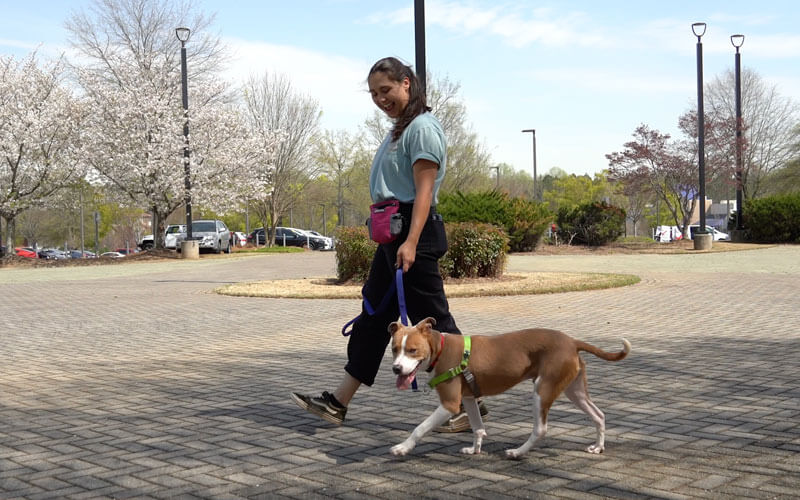We’ve partnered with Barking Hound Village to provide training resources for pet owners who need assistance. Learn more about preventing rude behavior in your dog by watching the video and reading the training guide below.

Ever wonder why dogs pull so much? It’s because of something called the opposition reflex, which causes their muscles to push even harder into a pull. When those muscles feel certain pressure, they naturally lean into that pressure, not away from it. And, of course, dogs pull because four paws almost always walk faster than two feet.
To begin teaching your dog to walk with a loose leash, start with the right equipment. Front-lead harnesses, allowing the pressure of a tight leash to come from the chest rather than the back or neck, do not trigger the opposition reflex like a back-lead harness or collar. Find the harness that fits your dog best. The harness should be tight enough to keep the clip of the leash on your dog’s chest, even when they’re pulling hard. If the clip of the leash ends up around your dog’s shoulder when they pull, you may want to try another harness or adjust the one you have.
Beyond the right equipment, the most important part of loose-leash training is consistency. If I tie your dog to a large tree, they’ll pull a few times and then stop because that tree is never going to allow your dog to pull it forward. But most people allow their dogs to pull far more than an inch, often through an entire walk. And guess what? The reward of continuing the walk is actively reinforcing the pulling behavior with every step. You might as well be giving your dog treats for pulling!
The simplest – though by no means easy – way to teach your dog not to pull is to never move forward when they do. When your dog starts pulling, stop immediately, maintaining a consistent length of leash with your hands close to your body. When your dog eases up on the leash – maybe they look back at you or sit – immediately start walking again. The resumed walk will reward the loose leash and encourage your dog to keep the leash loose in the future. But you have to be 100% consistent. There is no substitute for consistency with this behavior. If you continue to give your dog “treats” for pulling you on a leash when walking, even if it’s a fraction of the time, they will continue to regularly offer you the behavior in the future. It’s the definition of positive reinforcement.
Now, you may be thinking to yourself that if you stop every single time your dog pulls, you’ll never get anywhere. That’s why it’s important to take the time to practice in an easy environment like your back yard or inside your home, when you have the time to be patient with your dog and not when you’re trying to get them (or yourself) as much exercise as possible. Before moving to a more distracting environment like the sidewalks in your neighborhood, master loose-leash walking in these easier areas.
Another reason dogs pull on a leash is because we tend to be boring on walks whereas the world is fascinating. Add a little interest to your end of the leash by practicing treat-based training exercises on your walks. Stop and ask your dog to “sit” and reward them when they listen. We also love a “touch” exercise for young dogs, teaching them to touch your hand with their nose, which can help refocus their attention back to you. Rub a stinky treat on your hand and then hold it a few inches in front of your dog and say, “touch.” When they touch your hand with their nose, praise them immediately and give them the treat from your other hand. As your dog improves, try it farther and farther away from them. You’d be surprised how quickly your dog stays by your side on walks when they know that they can earn something delicious every once in a while .
If your dog still treats you like a sled, pulling you up and down the road, Barking Hound Village can help! Some dogs are champion pullers and there are plenty of techniques that you can teach them to maintain a loose leash while walking. You can find out about Barking Hound Village’s services by visiting their website or contacting them at (404)-369-2014 or training@barkinghoundvillage.com.

